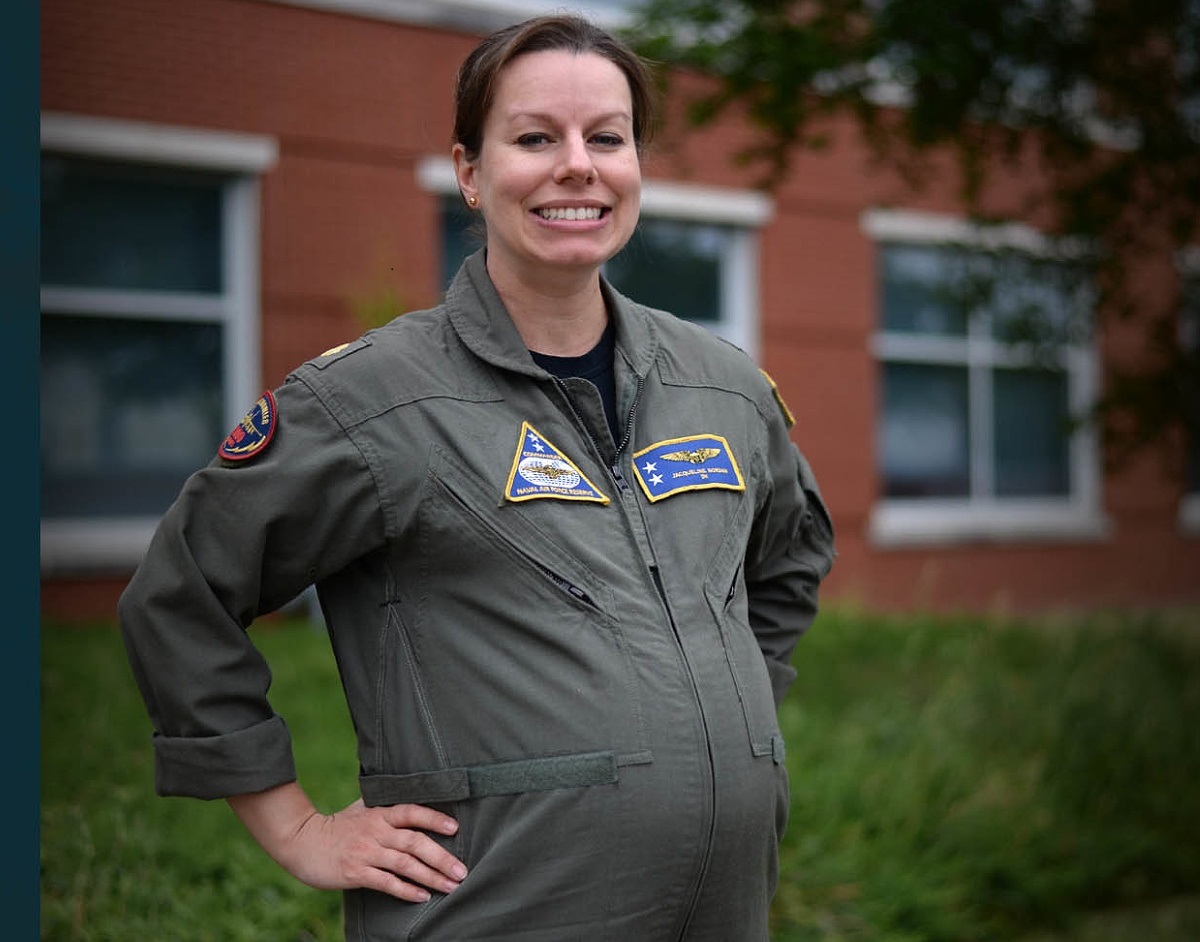
The Navy welcomed its first female aviators in 1974. A mere 47 years later, it’s giving pregnant pilots a flight suit that fits them.
The service quietly issued the first maternity flight suit to Lt. Cmdr. Jacqueline Nordan, a mobilization program manager in the Naval Air Force Reserve, as part of an early distribution program, officials said this week. Several other pregnant members of the command also received the uniform in a test run to determine its usefulness, Navy spokeswoman Amie Blade told Military.com.
The Navy also began issuing the flight suit more broadly in May via an Aircrew Systems Advisory to the fleet, Blade said.
“An Interim Rapid Action Change was drafted for the aircrew clothing maintenance manual informing the maintainers on the procedures for how to acquire a maternity flight suit,” she said.
All pregnant Navy aircrew members are now eligible to wear the garment, which features adjustable side panels and provides a snugger, more professional fit as an aviator’s pregnancy progresses.
Read Next: Civilian-Trained Pilots May Get Leg Up in Air Force Career Through New Program
“Prior to the maternity flight suit, pregnant aircrew have generally collected larger sized flight suits and gone up through additional sizes throughout their pregnancy, potentially needing three to five additional flight suits,” Nordan, who has previously been assigned to an EA-18G Growler squadron, said in the release. “Wearing a larger-sized flight suit results in longer hems and sleeves, potentially presenting a safety hazard in the aircrew cleared to fly during pregnancy.”
She added that baggy and oversized flight suits simply look unprofessional.
“Pregnant aircrew who are not flying are still conducting squadron business,” she said. “They’re still instructing classes, working in simulators, giving briefings, and representing their organizations. It makes a big difference to be able to continue to represent ourselves professionally in a well-fitting uniform throughout a pregnancy.”
It was actually the safety hazard of the larger flight suits that prompted development of the maternity uniform, Blade said.
“A single adjustable flight suit can expand across multiple trimesters depending on each pregnancy, saving pregnant aircrew the added expense associated with purchasing multiple flight suits, as well as the cost of tailoring larger-sized flight suits historically purchased to accommodate the changing pregnant form,” she said. “The expandable side panels allow aircrew to wear their usual length arms and hems, decreasing the risk of safety hazards.”
But most pregnant naval aviators are still stuck on the ground. While the Air Force has moved in recent years to create policies allowing pregnant pilots to fly for a greater portion of their pregnancies if they choose, the Navy has yet to follow suit.
According to Navy guidance updated in 2017, pregnancy is considered a disqualifier for flying duties, although aircrew members may request a waiver requiring approval from a local board of flight surgeons.
“Designated Naval Aviators who are authorized to fly during pregnancy shall perform flight duties in a Medical Service Group 3 capacity only,” the guidance states. That category refers to aviators limited to operating aircraft with dual controls and accompanied on all flights by a pilot or copilot with a less-restrictive medical qualification.
Single-pilot, ejection seat and high-performance aircraft that can pull more than 2 Gs are entirely off-limits, as are planes that conduct shipboard operations and those with cabin altitudes that exceed 10,000 feet. And after the third trimester begins, flying is banned entirely.
In 2019, the Air Force got rid of a medical waiver requirement for pregnant pilots who wanted to fly later into their pregnancies. It also expanded the standard flight-duty window for pregnancy by five weeks, allowing pregnant pilots to fly from weeks 12 to 28 if they choose. Later the same year, Lt. Col. Jammie Jamieson, a member of the Air Force Women’s Initiative Team, said the service was evaluating the science with an eye to further reducing restrictions.
The Air Force has also taken steps to design and buy maternity flight suits, launching solicitation and test efforts in 2020. The initiative caught the attention of conservative pundit Tucker Carlson earlier this year. He featured a photo of an Air Force captain wearing one of the flight suit prototypes and scoffed, saying such efforts were making “a mockery of the U.S. military.”
Military leaders from across the services were swift to condemn Carlson’s attack.
“Women lead our most lethal units with character,” Sergeant Major of the Army Michael Grinston responded in a tweet. “They will dominate ANY future battlefield we’re called to fight on.”
— Hope Hodge Seck can be reached at [email protected]. Follow her on Twitter at @HopeSeck.
© Copyright 2021 Military.com. All rights reserved. This material may not be published, broadcast, rewritten or redistributed.
